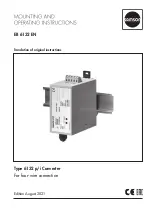
3.3. Battery and battery lead requirements
In order to utilize the full capacity of the product, batteries with sufficient capacity and battery cables with sufficient cross section
should be used. The use of undersized batteries or battery cables will lead to:
• Reduction in system efficiency.
• Unwanted system alarms or shutdowns.
• Permanent damage to system.
See table for MINIMUM battery and cable requirements.
Model
Battery capacity Pb
200 Ah
Battery capacity Lithium
50 Ah
Recommended DC fuse
125 A - 150 A
Minimum cross section (mm2) per + and - connection terminal
0 - 2 m
35 mm
2
2 - 5 m
70 mm
2
Consult battery manufacture recommendations to ensure the batteries can take the total charge current of the
system. Decision on battery sizing should be made in consultation with your system designer.
Use a torque wrench with insulated box spanner in order to
avoid shorting the battery.
Maximum torque: 14 Nm
Avoid shorting the battery cables.
• Undo the two screws at the bottom of the enclosure and remove the service panel.
• Connect the battery cables.
• Tighten the nuts well for minimal contact resistance.
3.4. Solar array configuration
The maximum operational input current for each tracker is 18A.
MPPT PV inputs are protected against reverse polarity, to a maximum short circuit current of 20A for each tracker.
Connecting PV arrays with a higher short circuit current is possible, as long as connected with correct polarity. This outside of
specification potential allows for system designers to connect larger arrays, and can be useful in case a certain panel
configuration results in a short circuit current just slightly above 20A, or to oversize the array to take care of winter versus summer
PV yield.
While functional with correct installation, BEWARE that the product warranty will be void if a PV array with a
short circuit current larger than 20A array is connected in reverse polarity.
When the MPPT switches to float stage it reduces battery charge current by increasing the PV Power Point voltage.
The maximum open circuit voltage of the PV array must be less than 8 times the minimum battery voltage when at float.
For example, where a battery has a float voltage of 54.0 volts, the maximum open circuit voltage of the connected array cannot
exceed 432 volts.
Where the array voltage exceeds this parameter the system will give a "Over-charge Protection" error and shut down.
To correct this, either increase the battery float voltage, or reduce PV voltage by removing panel from the string.
3.4.1. Inverter RS Example PV Configuration
This is an example of an array configuration. The decision on the specific array configuration, sizing and
design for your system should be made in consultation with your system designer.
Inverter RS Smart
Page 6
Installation
Содержание Inverter RS Smart
Страница 1: ...Inverter RS Smart Rev 03 02 2021 ENGLISH ...
Страница 23: ...7 Appendix Inverter RS Smart Page 21 Appendix ...
Страница 24: ...7 1 Appendix A Connection Overview Figure 2 Inverter RS Front Inverter RS Smart Page 22 Appendix ...
Страница 25: ...Figure 3 Inverter RS Bottom Inverter RS Smart Page 23 Appendix ...
Страница 27: ...7 2 Appendix B Block Diagram MPPT BATTERY 48V PV IN 230 Vac Inverter RS Smart Page 25 Appendix ...









































